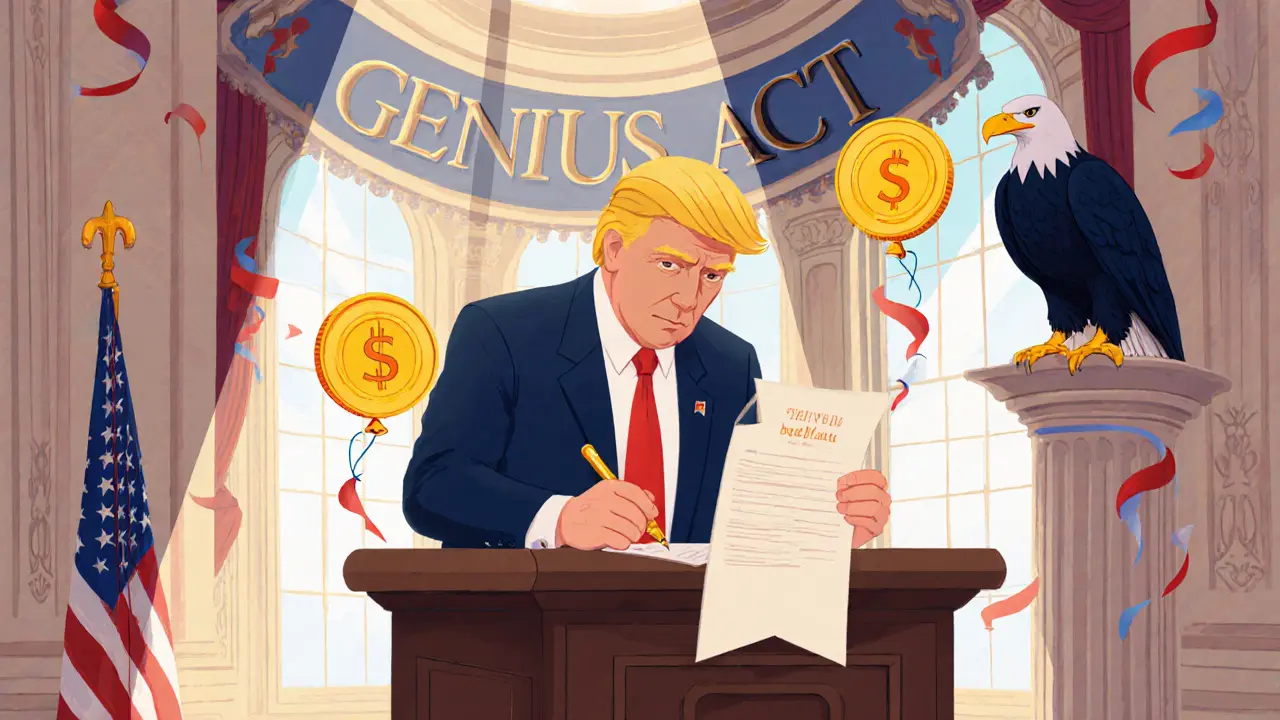GENIUS Act Compliance Checker
Compliance Check Results
When President Donald J. Trump signed the GENIUS Act (Guiding and Establishing National Innovation for U.S. Stablecoins Act of 2025) into law on July 18, 2025, the United States finally put a national, federal framework around payment stablecoins. The legislation promises consumer protection, a level playing field for issuers, and a clear path for stablecoins to sit alongside traditional dollars. The GENIUS Act is set to kick in on January 18, 2027, or 120 days after the final regulations are published, whichever comes first.
What the Act Actually Governs
A "payment stablecoin" under the act is a digital token whose value is pegged to a specific amount of U.S. currency and that is meant to be used for payments or settlement. The issuer must pledge to redeem each token one‑for‑one at the fixed monetary value. Anything that falls outside that definition - such as utility tokens or speculative stablecoins - remains outside the federal scope.
Who Can Issue a Stablecoin?
The law draws a hard line: only insured depository institutions banks, credit unions, bank subsidiaries, and non‑bank financial firms approved by the Federal Reserve may become "permitted payment stablecoin issuers" (PPSIs). This restriction means that a fintech startup can’t launch a stablecoin unless it partners with a qualified bank that has Federal Reserve approval.
Reserve Requirements - The 1:1 Rule
Every issued stablecoin must be backed 1:1 by low‑risk assets. Acceptable reserves include:
- Physical U.S. currency
- U.S. Treasury bills
- Approved repurchase agreements (repos)
- Other assets the Federal Reserve the central bank of the United States deems low‑risk
Issuers must publish a detailed reserve composition report every quarter and have an independent public‑accounting firm audit the reserves annually.
Custody, Segregation, and Re‑hypothecation
Custodial services for the stablecoin or its underlying private keys are limited to entities under banking regulator oversight. The act forces segregation of reserve assets - they can’t be mixed with the issuer’s other balance‑sheet items except for very narrow exceptions.
Re‑hypothecation is largely prohibited. The only allowed use of reserve assets is to meet reasonable redemption demand, which can involve pledging Treasury bills into short‑term repos cleared by an approved central counterparty. This balances liquidity needs with the requirement that the reserves stay safe.
Oversight Body: The Stablecoin Certification Review Committee (SCRC)
The Stablecoin Certification Review Committee a federal panel chaired by the Secretary of the U.S. Department of Treasury (including the Federal Reserve Chair and the FDIC Chair) sets the national standards. The SCRC reviews state‑level stablecoin regimes and decides if they are “substantially similar” to the federal framework. In practice, the committee can push states to align their rules or accept the federal stance as the de‑facto standard.
Anti‑Money‑Laundering (AML) & Consumer Protection
All PPSIs must comply with the Bank Secrecy Act the U.S. law that mandates AML and CFT procedures. This includes real‑time transaction monitoring, reporting suspicious activity, and maintaining robust Know‑Your‑Customer (KYC) processes. Consumer‑protection clauses also require clear disclosures about redemption terms, reserve composition, and any fees.

Implementation Timeline and Compliance Roadmap
The act gives issuers an 18‑month window from enactment to achieve full compliance, or 120 days after the final implementing regulations are released. The timeline looks like this:
- July2025 - Law signed
- Jan2026 - Draft regulations published for comment
- July2026 - Final regulations released
- Jan2027 - Law takes effect (or 120days after final regs)
This staggered approach allows banks to set up reserve‑management systems, upgrade AML infrastructure, and negotiate custodial partnerships.
Impact on the U.S. Stablecoin Market
Because the United States accounts for roughly 30% of global stablecoin transaction volume, the GENIUS Act is poised to reshape the market in three ways:
- Clarity for investors: Firms now know exactly what reserves and reporting are required, reducing speculative risk.
- Barrier to entry for newcomers: Only well‑capitalized, federally‑approved banks can issue payment stablecoins, which may limit the number of new projects but raises overall safety.
- Competitive edge abroad: By setting a high‑standard, U.S. regulators hope to attract stablecoin projects that need a reliable, dollar‑backed infrastructure.
International Context - How the U.S. Stands
Other jurisdictions have moved fast. Hong Kong’s Stablecoin Ordinance (May2025) and the EU’s MiCA regulations both focus on reserve transparency, but the U.S. framework is the first to tie stablecoin issuance strictly to insured depository institutions. This could make the U.S. the “Goldilocks” market-strict enough for safety, yet large enough to offer a meaningful user base.
Potential Friction Points
Despite its ambitions, the act leaves a few gray areas:
- State‑level fragmentation: While the SCRC can deem state regimes "substantially similar," enforcement remains uneven, especially in states that have already passed crypto‑friendly laws.
- Innovation slowdown: Requiring a bank partner may deter fintech startups that rely on agile, non‑bank structures.
- Regulatory overlap: Some issuers could fall under both the Securities and Exchange Commission (SEC) and the SCRC, creating duplicate filing burdens.
Stakeholders are already lobbying for clearer guidelines around these issues.
Key Takeaways for Market Participants
If you’re a stablecoin project, here’s a quick checklist:
- Secure a partnership with an insured depository institution that has Federal Reserve approval.
- Design a reserve fund composed exclusively of physical cash, Treasury bills, or approved repos-maintain a strict 1:1 ratio.
- Implement robust AML/KYC systems that satisfy the Bank Secrecy Act.
- Prepare quarterly reserve‑composition reports and annual independent audits.
- Plan for custodial services that are provided by a federally‑regulated entity.
Following this roadmap will put you on the fast track to becoming a "permitted payment stablecoin issuer" once the law takes effect.
Comparison of Core Requirements vs. Traditional Bank Products
| Aspect | Stablecoin Issuer (GENIUS Act) | Traditional Bank Deposit |
|---|---|---|
| Entity Eligibility | Only insured depository institutions with Fed approval | Any chartered bank or credit union |
| Reserve Backing | 1:1 with cash, Treasury bills, approved repos | Fractional reserve banking allowed |
| Audit Frequency | Quarterly public reserve report + annual independent audit | Annual audit, no public reserve disclosure |
| Custody Restrictions | Custody must be with regulated entity, segregation required | Custody integrated into bank balance sheet |
| AML/CFT Compliance | Full BSA compliance, real‑time monitoring | Standard BSA compliance |
| Regulatory Oversight | SCRC + Fed + FDIC + state regulators | Fed, OCC, FDIC, state banking authorities |
What’s Next?
Regulators will release the detailed implementing regulations by mid‑2026. Expect a flood of public comments from fintech firms, consumer‑advocacy groups, and traditional banks. Keep an eye on the SCRC’s quarterly releases - they will signal how strictly the "substantially similar" test will be applied to state laws.
For anyone watching the stablecoin space, the GENIUS Act is the first real attempt to blend innovation with the safety net of the U.S. banking system. Whether it will foster a thriving, dollar‑backed stablecoin ecosystem or stifle new entrants remains to be seen, but the stakes are high for the future of digital payments.

Frequently Asked Questions
What is a "payment stablecoin" under the GENIUS Act?
A payment stablecoin is a digital token whose value is pegged to a fixed amount of U.S. dollars and is intended to be used for payments or settlement. The issuer must redeem each token at the exact dollar value, and the token must be fully backed by low‑risk reserves.
Which entities can become a permitted payment stablecoin issuer?
Only insured depository institutions - banks, credit unions, bank subsidiaries, or non‑bank financial firms that have received Federal Reserve approval - may be designated as a permitted payment stablecoin issuer.
How are reserve assets managed and reported?
Reserves must be held 1:1 in physical cash, U.S. Treasury bills, or approved repurchase agreements. Issuers publish a quarterly reserve composition report and undergo an annual audit by a registered public‑accounting firm.
What role does the Stablecoin Certification Review Committee (SCRC) play?
The SCRC, chaired by the U.S. Treasury Secretary and composed of the Federal Reserve Chair and FDIC Chair, sets national standards, reviews state‑level regimes for "substantial similarity," and can issue certifications that allow issuers to operate across the country.
When does the GENIUS Act actually take effect?
The law becomes effective on January18,2027, or 120days after the final implementing regulations are issued, whichever occurs first.


Comments
Debby Haime
Wow, the GENIUS Act finally gives stablecoins a concrete playground! This is massive for anyone working on a dollar‑pegged token because now we have a clear rulebook instead of vague guidance. The eligibility clause means you can’t just pop a crypto startup and start minting – you need a bank or Fed‑approved firm. That’s a big hurdle, but it also adds credibility that investors love. The 1:1 reserve requirement is a breath of fresh air; no more fractional‑reserve tricks. Quarterly public reserve reports will push transparency to the forefront. And the annual independent audit? That’s the kind of oversight the industry desperately needed. The SCRC’s role sounds like a solid governance layer, melding Treasury, Fed and FDIC expertise. Real‑time AML monitoring will keep the bad actors at bay while protecting consumers. The timeline gives firms a realistic runway to get compliant – you have until early 2027 or 120 days after regs drop. Overall, this act could be the catalyst that turns stablecoins from experimental to mainstream. Let’s see how the market reacts once the rules are finalized. 🚀
March 14, 2025 AT 18:07
emmanuel omari
The GENIUS Act is a decisive move that finally puts U.S. stablecoin regulation on par with global standards, ensuring only reputable financial institutions can issue payment stablecoins and eliminating the wild west of unbacked tokens.
March 20, 2025 AT 20:39
Andy Cox
pretty solid framework gives clear rules for banks and fintechs good to see regs finally catch up with the tech
March 26, 2025 AT 23:10
Courtney Winq-Microblading
Reflecting on the philosophical underpinnings, the Act seems to draw a line between speculative constructs and genuine monetary instruments, echoing centuries‑old debates about what constitutes money. By anchoring stablecoins to low‑risk assets, lawmakers are essentially demanding substance over hype. It raises an interesting question about the nature of trust in digital finance: is trust derived from regulatory endorsement or from the intrinsic stability of the backing? In any case, the requirement for a bank partnership could foster a symbiotic relationship where the fintech's agility meets the bank's credibility. This could be a model for future financial innovation, blending the best of both worlds.
April 2, 2025 AT 01:42
katie littlewood
Alright, let me break this down step by step because there’s a lot to unpack. First, the eligibility requirement that only insured depository institutions or Fed‑approved non‑bank firms can issue stablecoins is a massive shift from the open‑source, DIY ethos many crypto projects have been operating under. This means that any startup with a brilliant idea for a dollar‑backed token now has to find a banking partner that not only has the right charter but also the appetite to get involved in a space that’s still relatively nascent. Second, the 1:1 reserve rule eliminates any fractional‑reserve gymnastics that have plagued traditional banking for centuries; you’re forced to hold physical cash, Treasury bills, or approved repos, which adds a layer of security for end‑users. Third, the quarterly public reserve composition reports are essentially a forced transparency measure that could usher in a new era of accountability, allowing anyone to audit the backing assets without needing a privileged insider connection. Fourth, the annual independent audit requirement goes beyond the typical internal controls most fintechs have and brings in an external, unbiased perspective that can catch discrepancies early. Fifth, custodial services being restricted to federally regulated entities prevents the kind of “wild west” custody solutions that have historically been a point of failure in the crypto world; this mitigates the risk of a custodian disappearing with the assets. Sixth, the real‑time AML/KYC monitoring mandated by the Bank Secrecy Act ensures that illicit actors find it difficult to use stablecoins for money laundering, which should improve the overall perception of stablecoins as a legitimate payment method. Seventh, the creation of the Stablecoin Certification Review Committee (SCRC) centralizes oversight and provides a clear avenue for state‑level regimes to be harmonized, potentially reducing regulatory fragmentation across the country. Eighth, the timeline gives issuers roughly an 18‑month window to comply, which is generous enough for institutions to build the necessary infrastructure without rushing, yet tight enough to prevent indefinite procrastination. Ninth, the act’s impact on competition is dual‑edged: while it raises the barrier to entry for small players, it also filters out bad actors and could attract larger, more reputable projects that need a stable, regulated environment to scale. Tenth, on the international front, the U.S. is positioning itself as a “Goldilocks” market-strict enough for safety but large enough to be attractive-potentially drawing projects away from jurisdictions with looser standards. Eleventh, there’s a potential friction point with existing SEC regulations, as some entities might find themselves under both SCRC and SEC jurisdiction, leading to duplicate filing obligations. Twelfth, state‑level fragmentation, despite the SCRC’s authority, could still cause legal gray areas, especially in states that have already passed crypto‑friendly laws. Thirteenth, the act could slow down innovation for fintech startups that lack the resources to partner with a big bank, potentially stifling creative solutions. Fourteenth, the public disclosure requirements could lead to increased market scrutiny, making it easier for competitors to copy strategies based on the published data. Fifteenth, the act’s emphasis on low‑risk assets could push the market toward more conservative investment strategies, possibly reducing yields for token holders. Sixteenth, the overall effect is likely to be a more stable and trustworthy stablecoin ecosystem, albeit at the cost of reduced entry for smaller innovators. Finally, all these moving parts together paint a picture of a regulatory environment that tries to balance safety, transparency, and innovation, and only time will tell if it hits that sweet spot.
April 8, 2025 AT 04:14
Jenae Lawler
While one might commend the comprehensive nature of the GENIUS Act, it must be observed that its stringent eligibility criteria effectively excise the very entrepreneurial spirit that has propelled fintech advancement. The requirement for a federally‑approved banking partner, though ostensibly prudent, imposes a formidable barrier to entry for nascent innovators lacking such institutional affiliations. Moreover, the obligatory public disclosure of reserve compositions, albeit enhancing transparency, could inadvertently disclose competitive intelligence, thereby disincentivising market participation. In sum, the act, though well‑intentioned, appears to favor established incumbents at the expense of disruptive potential.
April 14, 2025 AT 06:45
Ben Dwyer
Great breakdown, everyone. If you're gearing up for compliance, start mapping out your bank partnership early – the onboarding process can be lengthy. Also, set up a clear audit trail now so the quarterly reports won't feel like a nightmare later.
April 20, 2025 AT 09:17
Lindsay Miller
Totally agree, having the audit plan in place from day one saves a lot of headaches down the road. It also builds confidence with your banking partner.
April 26, 2025 AT 11:48
Katrinka Scribner
this act is 🔥 but also 💔 for indie devs 😭 gonna need big‑bank love now 😅
May 2, 2025 AT 14:20
VICKIE MALBRUE
Looks good enough
May 8, 2025 AT 16:52
Waynne Kilian
Let’s hope the coordination between federal and state regulators stays smooth; otherwise we might see a patchwork of rules that confuses everyone.
May 14, 2025 AT 19:23
Naomi Snelling
Honestly, I think the whole thing is just a front to give the Fed even more control over money flows while pretending it’s about consumer protection.
May 20, 2025 AT 21:55
Michael Wilkinson
While your concerns are noted, the act’s focus on real‑time AML monitoring directly addresses the very issues you raise about illicit activity.
May 27, 2025 AT 00:26
Billy Krzemien
The clarity introduced by mandatory quarterly reserve disclosures will likely improve market confidence, as stakeholders can verify that each token is fully backed by low‑risk assets. Precise documentation also simplifies regulator audits, reducing the likelihood of ambiguous compliance interpretations.
June 2, 2025 AT 02:58
april harper
Looks like another bureaucratic hurdle; I guess we’ll see if anyone actually builds on this.
June 8, 2025 AT 05:29
Clint Barnett
From a mentorship perspective, the GENIUS Act could serve as a valuable case study for how regulatory frameworks evolve to accommodate emerging technologies. It showcases the delicate balancing act between fostering innovation and safeguarding the financial system, illustrating the importance of stakeholder engagement throughout the rule‑making process. By analyzing the act’s components-eligibility, reserve requirements, audit cadence, and custodial constraints-students can grasp how each element contributes to overall systemic resilience. Moreover, the timeline for compliance offers a practical example of phased implementation, allowing firms to iteratively build capacity while regulators monitor progress. In short, this legislation not only shapes the stablecoin landscape but also provides a rich educational resource for future fintech leaders.
June 14, 2025 AT 08:01
Jacob Anderson
So basically, the government finally decided to tell crypto people how to play nice-what a surprise.
June 20, 2025 AT 10:33
Kate Nicholls
The act’s emphasis on transparency is commendable, yet the practical burden on smaller firms remains a concern.
June 26, 2025 AT 13:04
Carl Robertson
Finally some real rules.
July 2, 2025 AT 15:36